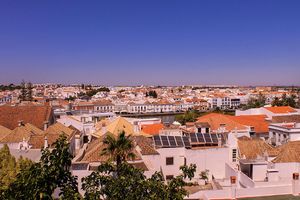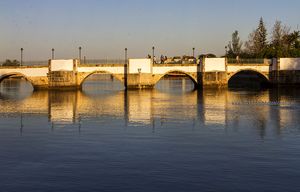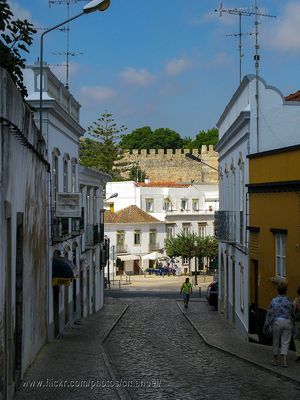
Tavira, Portugal
Why not visiting Tavira, one of the most attractive and natural areas of Algarve?
Tavira is located in the eastern side of Algarve, 30 minutes to Ayamonte (Spain) and more or less the same to the Faro International Airport. It is a nice city crossed by the Gilão River. Both sides of the city are connected by a nice Romanesque bridge of seven arches.
Tavira is the perfect place to have a walk. It has a really nice old city centre made up by a labyrinth of streets with beautiful pavements. The centre hides gardens and wooded squares, churches, and worth-to-visit mansions. The city also has a small fishing port and a modern market.
Tavira is a wonderful starting point to explore the eastern side of Algarve, as it has wonderful restaurants, hotels, and tourist businesses.
A good idea to explore the city is to access it by its Porta de Dom Manuel I Door and start by visiting the Igreja da Misericórdia Church, built between 1541 and 1551 and considered the most important Renaissance building in Algarve. Next to it, if you climb the stairs from the left side of the church you’ll find the Galería Palace, housing several exhibitions. Once in here, don’t miss the chance to visit the castle walls, from where you’ll get amazing views over the city. After this it is a good option to visit the Igreja de Santa María do Castelo Church, built between the 13th and 14th centuries and refurbished after the 1755 earthquake. If you go down from the garden located in front of the church, on the right, you’ll find the Archaeological Nucleus of the Almohad quarter and the Pousada situated in the Nossa Senhora da Graça Convent. If you turn left you’ll see the Igreja Matriz de Santiago Mother Church, dating back to the mid-13th century and refurbished too after the 1755 earthquake.
Afterwards it is recommendable to go down the Rua Libertade, a very lively street with cafes, to arrive to the Praça da República Square, where is the Islamic Museological Nucleus, dealing with the relevance of the Islamic period in Tavira and exhibiting a compilation of items from several archaeological excavations. In this compilation stands out the Vaso de Tavira. After this, it is recommendable to walk by the river to approach the old Municipal Market (Mercado da Ribeira), nowadays a commercial and hotel business space.
In this area it is possible to visit the Igreja de São Pedro Gonçalves Telmo Church, sailors patron saint patrón de los marineros, located in the Rua D. Marcelino Franco Street, in front of the António Pinheiro Cinema. If you cross the bridge you’ll also find important religious buildings, the Igreja de São Paulo Church, the Igreja do Carmo Church and the Ermida da Santa Ana Shrine. In this side you’ll also find the Centro de Ciencia Viva (Life Science Centre of Tavira).
Tavira also has a vast nature heritage in the littoral, spheroidal weathering, and mountains. The ecosystems and habitats variety in Tavira means a great diversity of animals and plants species, creating a very important ecological wealth.
The coast of Tavira is made up by the Ría Formosa Nature Park, meaning one of the most important migratory birds areas in the country, especially for waders and anatidae. The Ría Formosa Nature park has a sandy dunes area in the littoral with beaches and dunes protecting the lagoons area. The large dunes system reaches from Ancão (Loulé) until Manta Rota (Vila Real de San Antonio), including a great variety of habitats: barrier islands, marshlands, sand and mud banks, dunes, salinas, sweet and salty water lagoons, water courses, forests agricultural areas, etc. The animals living in the Ria Formosa Estuary, the salinas and the salt marshes, are really important for Tavira, as in here it is possible to see a large number of wet areas species.
In the mountains stand out the Serra do Caldeirão Mountains, the largest mountain ran in Algarve, that reaches from Ribeira de Odelouca until the northeast reservoirs. Its highest point in in Tavira, in Alcaria do Cume (535 metres high). It is a rounded-elevation landscape with a thick hydrographic network formed by temporary water courses on the hillsides and riparian areas, standing out the ash. The Serra do Caldeirão Mountains are made up by pleasing stones, especially with rockroses. Here stand out the Bonelli’s eagle, deers, wild boars, rabbits and hares.
This area has non-irrigated agriculture, of almonds, carobs and olives. The flora stands out for the cork oak, holm oak, pines, and eucalyptus.
If you like sardines, the 23rd and 24th June are the perfect dates to visit it, when the city festivities are celebrated. During these days the streets are dressed with beautiful paper flowers and boasts of a lively nightlife. In the summer there also are lots of attractions: pop, rock, jazz and classical music concerts; theatre shows, thematic fairs, street entertainment, etc.
Recommended Excursions:
Mapa Interactivo:
Tavira
What to see:
- Tavira Castle
- Igreja de Santa María do Castelo Church of Tavira
- Igreja de Santiago Church
- Igreja da Misericórida Church
- Tavira Municipal Museum
- Igreja de São Paulo Church
- São Sebastião Chapel
- Nossa Senhora da Piedade Sanctuary
- Santa Ana Shrine
- Rato Fort
- Pego do Inferno
- Ría Formosa Natural Park
- Serra do Caldeirão
- Beaches:
- Praia do Barril Beach
- Praia da Terra Estreita Beach
- Praia da Ilha de Tavira Beach
- Beach of Cabanas Island
Other worth-visiting nearby towns and cities:
Why "Portugal Travel"?
Portugal Travel is an organization of Portuguese agencies whose objectives are:
- ✓ To make Portugal, its culture and its heritage known.
- ✓ To promote sustainable tourism.
In collaboration with:
Escola Superior de Hotelaria e Turismo do Estoril
Turismo de Portugal
Copyright PortugalTravel.org © - All rights reserved.







